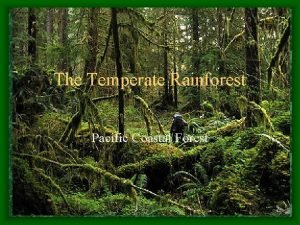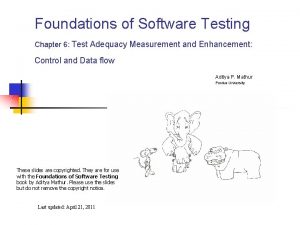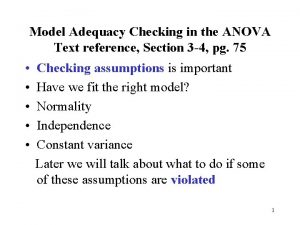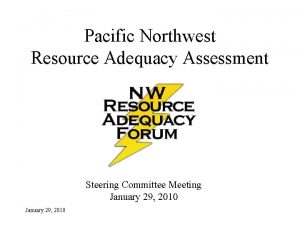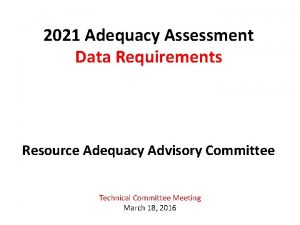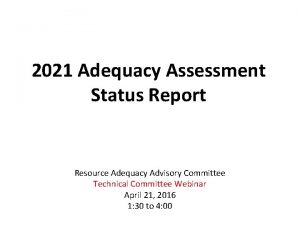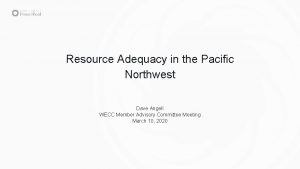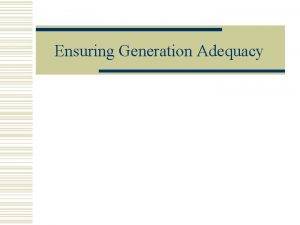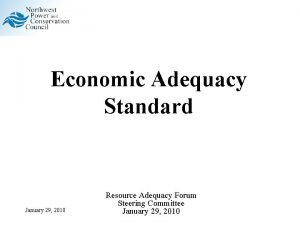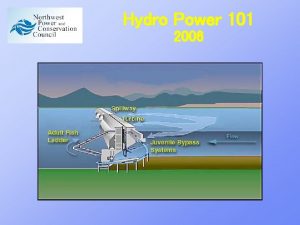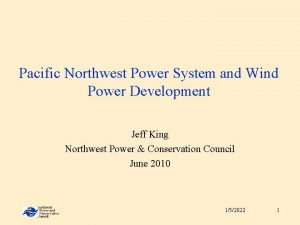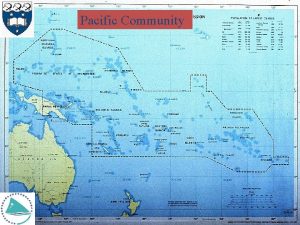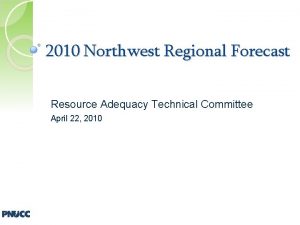Adequacy Assessment for the 2017 Pacific Northwest Power











































- Slides: 43

Adequacy Assessment for the 2017 Pacific Northwest Power Supply Steering Committee Meeting October 26, 2012 Portland, Oregon 1

Outline § Final 2017 Resource Adequacy Assessment § Changes since August Draft § Additional Slides (if needed) 2

NW Adequacy Standard § Metric: Loss-of-load probability (LOLP) § Threshold: Maximum of 5 percent § LOLP is the probability that extraordinary actions would have to be taken in a future year to avoid curtailment of electricity service § Calculated assuming existing resources only and expected efficiency savings 3

2017 Assessment § The expected LOLP is 6. 6% § January, February and August most critical months § Interpretation: Interpretation Relying only on existing resources and expected efficiency savings yields a power supply in 2017 whose likelihood of curtailment exceeds our agreed upon threshold 4

2017 Monthly LOLP 5

Actions to Alleviate Inadequacy § 350 MW of new generating resource capacity drops the expected LOLP to 5% § Equivalently, 300 MWa of additional energy efficiency does the same – Equals 50 MWa per year above the target – Which was accomplished in 2010 -11 § Demand response measures could also help § This is consistent with utility plans and the Council’s resource strategy 6

Major Assumptions § Existing resources (sited and licensed) § 6 th Power Plan conservation § Market supplies – NW: 3, 450 MW winter, 1, 000 MW summer – SW on-peak: 1, 700 MW winter, none summer – SW off-peak: 3, 000 MW year round § Council’s medium load forecast 7

Sixth Plan Target Efficiency Levels Year Incremental Savings (MWa) Cumulative Savings (MWa) 2010 200 2011 220 420 2012 240 660 2013 260 920 2014 280 1, 200* 2015 300 1, 500 2016 320 1, 820 2017 340 2, 160 *Council’s target for 2014 is 1, 200 MWa with a high-end range of 1, 400 MWa. Extrapolating this data yields a high-end value of 2, 400 MWa for 2017 (or 240 MWa more than the target). 8

Major Uncertainties § Explicitly modeled – Water supply – Temperature load variation – Wind – Forced outages § Not modeled explicitly – Economic load growth – Uncertainty in SW market 9

Effects of Uncertainties Load SW Winter Market LOLP Low High 2. 8% Low None 8. 4% High 7. 8% High None 16. 8% Expected 6. 6% 10

Variation in LOLP due to Load and Market 11

Illustration of LOLP Probability 12

Effects of Adding Resources § 350 MW of new resource moved the reference case LOLP of 6. 6% down to 5. 0% § 2, 850 MW of new resource moved a high LOLP of 13. 3% down to 5. 0% § Sum of utility planned* resources exceeds 3, 000 MW *In this context “planned” means request for proposals or RFPs. 13

Adding 350 MW of CCCT 14

Adding 2, 850 MW of CCCT 15

Changes Since the last Draft § Many changes were made based on comments from the technical committee § Expected LOLP changed from 6. 9 to 6. 6% 16

Revisions since August Draft § Code fix (related to Canadian operations, eliminated anomalous June curtailments) § 80 year hydro record and updated Canadian reservoir operations § LLH Summer purchase-ahead changed to 3000 MW (previous value was 1000 MW) § Net regional wind dedicated to serving regional load changed to 4266 MW due to removals, additions and adjustments (previous value was 4421 MW) 17

Revisions since August Draft § Thermal resource changes – IPP now 3451 MW (was 3586 MW) § Centralia 1 (670 MW IPP changed to 290 MW IPP and 380 MW firm) § Tenaska (245 MW firm changed to 245 MW IPP) – Firm 12746 MW changed to 12881 MW – Mill Creek/Dave Gates Generating Station changed to 47 MW (33% of 143 MW, previous value was 49. 5 MW – 33% of 150 MW) – Highwood Generating Station removed (previously supplied 13 MW) 18

Summer Thermal Derates 19

Illustration of Summer Derate 20

Revisions since August Draft § Wind capacity factor set – Studied 20 sets of temperature-correlated wind capacity factors, LOLP differed by 1 to 2% depending upon which set was used – Selected a set that tested at the middle of the LOLP range § Number of games – 6160 games ( = 80 hydro x 77 load), all unique combinations of water and load (wind is locked to load) 21

LOLP Surface Map from August 22

Current LOLP Surface Map 23

Effects of 70 -yr vs. 80 -yr hydro 24

Additional Slides 25

Final 2017 Assessment Results 26

Revisions since August Draft § Thermal resource changes – Summer derate for thermal plants § Project capacity is represented by a single number (winter capacity) § Reduced summer capacity is achieved through adjustment to the maintenance schedule § Reviewed summer and winter capacity figures and specific schedules in the White Book (from PNUCC submittals) to create customized maintenance schedules 27

Thermal derate schedules 28

Thermal derate schedules 29

Thermal derate schedules 30

Effects of 70 -yr vs. 80 -yr hydro § Run the reference case with 70 -yr hydro and 1000 MW summer purchase-ahead resource. Note that August issues, which are not as apparent with 80 -yr hydro, appear when switching back to 70 -yr hydro 31

Monthly LOLP § Monthly LOLP and EUE for each of the study cases is shown on the following charts 32

Monthly LOLP 33

Monthly LOLP 34

Monthly LOLP 35

January LOLP surface map 36

How much CT gets you to 5% § Add a CT resource that will bring study cases with >5. 0% LOLP down to 5. 0% 37

How much CT gets you to 5% 38

Add Standby Resources § Increase Standby Resources to bring study cases with >5. 0% LOLP down to 5. 0% 39

Effects of Adding Resources § 500 MW of additional standby resources moved the reference case LOLP of 6. 6% down to 5. 0% § 3, 500 MW of additional standby resources moved a high LOLP of 13. 3% down to 5. 0% § The existing standby resource thresholds are 660 MW Oct-Mar and 720 MW Apr-Sep 40

41

42

43
 Temperate rainforest characteristics
Temperate rainforest characteristics Pacific northwest serial killers
Pacific northwest serial killers Raven: a trickster tale from the pacific northwest
Raven: a trickster tale from the pacific northwest Pacific northwest gigapop
Pacific northwest gigapop Pacific northwest food
Pacific northwest food Pacific nw college credit
Pacific nw college credit Prenhd
Prenhd Pacific northwest smart grid demonstration project
Pacific northwest smart grid demonstration project Intermix
Intermix Active power reactive power apparent power
Active power reactive power apparent power The number of test of adequacy is
The number of test of adequacy is Condition coverage
Condition coverage Criterion of adequacy
Criterion of adequacy Horizontal and vertical adequacy
Horizontal and vertical adequacy Capital adequacy ratio formula
Capital adequacy ratio formula Certificate of adequacy
Certificate of adequacy What is a priori knowledge
What is a priori knowledge Adequacy
Adequacy Adequacy
Adequacy Cash flow adequacy ratio
Cash flow adequacy ratio Model adequacy checking anova
Model adequacy checking anova Liability adequacy test
Liability adequacy test Icass practical assessment task 2 2017 memorandum
Icass practical assessment task 2 2017 memorandum Assessment and reporting arrangements 2017
Assessment and reporting arrangements 2017 Kontinuitetshantering i praktiken
Kontinuitetshantering i praktiken Novell typiska drag
Novell typiska drag Tack för att ni lyssnade bild
Tack för att ni lyssnade bild Returpilarna
Returpilarna Varför kallas perioden 1918-1939 för mellankrigstiden?
Varför kallas perioden 1918-1939 för mellankrigstiden? En lathund för arbete med kontinuitetshantering
En lathund för arbete med kontinuitetshantering Särskild löneskatt för pensionskostnader
Särskild löneskatt för pensionskostnader Tidbok
Tidbok Anatomi organ reproduksi
Anatomi organ reproduksi Densitet vatten
Densitet vatten Datorkunskap för nybörjare
Datorkunskap för nybörjare Tack för att ni lyssnade bild
Tack för att ni lyssnade bild Hur skriver man en debattartikel
Hur skriver man en debattartikel Delegerande ledarskap
Delegerande ledarskap Nyckelkompetenser för livslångt lärande
Nyckelkompetenser för livslångt lärande Påbyggnader för flakfordon
Påbyggnader för flakfordon Tryck formel
Tryck formel Offentlig förvaltning
Offentlig förvaltning Lyckans minut erik lindorm analys
Lyckans minut erik lindorm analys Presentera för publik crossboss
Presentera för publik crossboss
